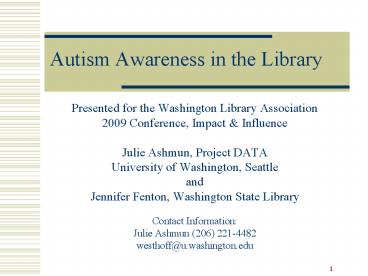Autism Awareness in the Library - PowerPoint PPT Presentation
1 / 23
Title:
Autism Awareness in the Library
Description:
More common in boys than girls. Genetic factors seem to play a role ... Time & Transitions consider that children, especially boys, love to be on the computer ... – PowerPoint PPT presentation
Number of Views:123
Avg rating:3.0/5.0
Title: Autism Awareness in the Library
1
Autism Awareness in the Library
- Presented for the Washington Library Association
- 2009 Conference, Impact Influence
- Julie Ashmun, Project DATA
- University of Washington, Seattle
- and
- Jennifer Fenton, Washington State Library
- Contact Information
- Julie Ashmun (206) 221-4482
- westhoff_at_u.washington.edu
2
What is Autism?
- Neurobehavioral disorder
- Life-long effects
- Onset of symptoms occurs in the first three years
of life - Spectrum disorder that varies in severity of
symptoms
3
- DSM-IV Criteria
Pervasive Developmental Disorders (PDD)
Pervasive Developmental Disorder Not otherwise
specified (PDD-NOS)
Aspergers Syndrome
Autistic Disorder
Childhood Disintegrated Disorder
Retts Disorder
4
- Common Usage
Autism Spectrum Disorders (ASD)
Aspergers Syndrome
PDD-NOS
Classic Autism
5
- . Brian Boys Club
6
Autism Facts
- Prevalence 1 in 150
- More common in boys than girls
- Genetic factors seem to play a role
- No known causes of autism
7
DSM IV defines autism by the following
characteristics
- Delays or abnormal functioning in at least one of
the following areas with onset prior to three
years - (1) social interaction,
- (2) social communication, or
- (3) restrictive, repetitive, and/or stereotyped
patterns of behavior
8
Social Deficits (DSM-IV)
- Impairment in nonverbal communication (gestures,
eye gaze, etc.) - Failure in developing peer relationships
- Lack of spontaneous sharing of enjoyment,
interests, etc. - Lack of social or emotional reciprocity
9
What You Might See
- Complete lack of interest in others
- Very attached to certain adults, but no interest
in peers - Inappropriate interest in others
- Wants friends, but doesnt get it
- Lack of understanding of facial expression
- Behavior problems related to lack of interest in
social praise or social consequences - Summer
10
Communication (DSM-IV)
- Delay in or total lack of spoken language
- Impairment in ability to initiate or sustain
conversation - Stereotyped use of language
- Lack of make-believe play
11
What You Might See
- Use of augmentative communication systems or no
communication system. - Children with very good language, but odd uses
pronoun reversals, strange uses of words. - Children with odd sounding language.
- Scripting
- Repetitive, unimaginative play or no play.
- Behavior problems because of limited language.
- Difficulty with processing language.
12
Restricted, Repetitive and Sterotyped Patterns of
Behavior (DSM-IV)
- Abnormally obsessive interests
- Rigid adherence to routines
- Sterotyped motor movements
- Preoccupation with parts of objects
13
What You Might See
- Obsessions with trains, maps, letters, etc.
- Hand flapping, vocalizing, spinning,
self-injurious behavior - Lack of interest in normal childhood activities
- Tantrums and other behavior problems around
routine changes - Behavior problems around obsessions
- Self stim
14
Sensory Processing, Attention, and Self-Regulation
- Hypersensitivity to sounds and lights
- Aversion to social touch
- Avoidance of food textures
- Lack of response to pain
- Poor orientation to visual stimuli
- Over-focused with sensory features of objects
(e.g. spinning objects, lights, vents) - Hypo-responsiveness to stimuli
15
Resources
- Autism Speaks
- www.autismspeaks.org
- Autism Society of America
- www.autism-society.org
- www.autismsource.org
- Autism Society of Washington, www.autismsocietyofw
a.org - Autism Research Institute
- www.autism.com
- Defeat Autism Now
16
Supporting Individuals with Autism in the Library
- Environmental Modifications
- Clear Visible Boundaries (e.g. color coding,
mapping, books to be restacked bucket) - Materials Organized
- Time Transitions consider that children,
especially boys, love to be on the computer - Rules Expectations
17
(No Transcript)
18
(No Transcript)
19
Visual Supports
- Are static and non-verbal
- Increase predictability and structure
- Enhance the communication process and serve as a
cue - Often do not require social interaction
20
(No Transcript)
21
(No Transcript)
22
Communication
- Simple, concise language
- Provide clear directions with picture prompts
when possible - Use language to define steps in a sequence (e.g.
first, then, last 1,2,3) - Reduce nonverbal communication (e.g. individual
may not be able to follow a point)
23
Ideas and Questions
- How can you provide more support for an
individual with autism and special needs in your
library? - Picture cues to go with the words to label area
- Comfy areas
- Clear rules for time limits and how to behave
- Other ideas?































